Being a plant person, you have plants all over your place, but if you also love pets, these two passions can conflict. Because most common indoor plants are not usually safe for your furry friends. The pets usually nibble onto the plants to play with them out of curiosity. Pet thing, you know! But don’t worry; you can add greenery to your home with indoor houseplants that are non-toxic and safe for your cats and dogs.

Having indoor plants is beneficial as they improve the air quality, ultimately positively affecting your health. But pet protection and their health is always your priority. Isn’t it? Whatever the reason, you need to ensure your pets do not get harmed by the household plants; otherwise, they can suffer from plant poisoning.
Indoor Houseplants Safe for Cats and Dogs
Since it is challenging to keep pets away from plants, the best possible solution is to choose those plants which are non-toxic for your pets. We understand your concerns because we are also big plant and pet lovers, so we have compiled a list of non-toxic indoor houseplants that will be safe for your cats and dogs.
1. Spider Plant
Scientific Name: Chlorophytum comosum
Spider plants are one of the most easy-going pet-friendly household plants. Even if you are away for days or have accidentally overwatered your plant, it is not likely to wither or wilt like other plants. Hence being one of the most low-maintenance thriving plants, spider plants should be among your top choices in the indoor houseplants that are safe for cats and dogs.
The green and white striped look elegant, especially while hanging down from the walls and balconies, and are also safe for fluffy fellows. Moreover, it is included in NASA’s list of indoor plants that clean the air.

Care Instructions
Spider plants are highly adaptable to the soil and environmental conditions. They don’t like direct sunlight. Therefore, keeping them in indirect sunlight with a small amount of water will save any extra effort required for other plants.
Related Article: How to Save a Dying Spider Plant?
2. Air Plants
Scientific Name: Tillandsia
Air plants are low-maintenance in a real sense as they don’t need any soil to grow and can thrive in low-light and low-water. Air plants make fantastic decor items when arranged in a terrarium. They look elegant and add beauty to your indoors. Moreover, these plants are completely pet-friendly.
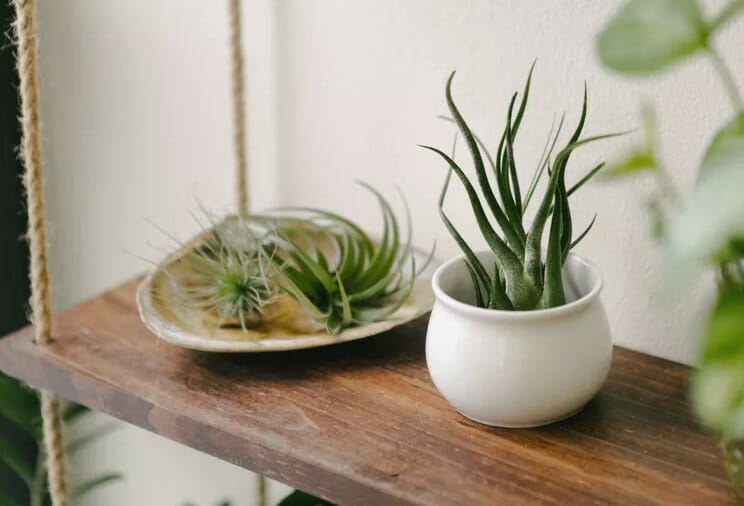
Care Instructions
Air plants do not like direct sunlight, so keep them in indirect sunlight. For watering, soak them in water once a week.
3. Baby Tears
Scientific Name: Soleirolia soleirolii
As cute as the name sounds, baby tears look super adorable, especially in basket-shaped pots. The branches hang down with the tiny baby leaves on them, adding to the aesthetic aspect of your house. No matter how often your pets attempt to jump and chew onto them, they will not get their stomach upset or poisoned.
At first, it covers the whole pot with fresh greeny leaves, and then the branches start handing down from the pot. You can keep them anywhere, preferably hang them on balconies and rest assured that your fluffy friends are not at risk due to this non-toxic house plant.
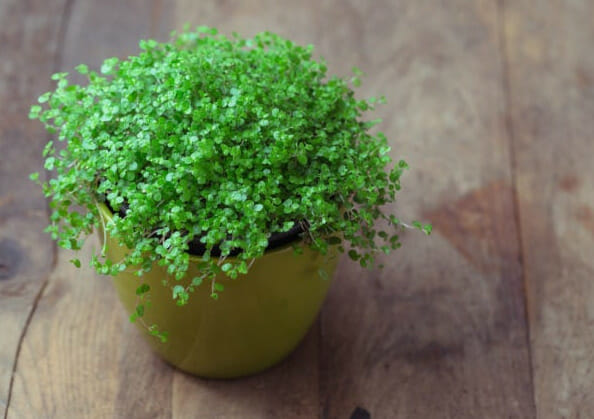
Care Instructions
Baby’s tears don’t like intense direct sunlight. However, indoors they grow well under artificial grow lights. Use well-draining soil, and keep the soil moist. However, the soil should not be soggy due to overwatering. So, you can water after every 5-7 days.
4. Parlor Palm
Scientific Name: Chamaedorea elegans
The parlor palm is one of the easiest palms to grow indoors. The small tree-like palm leaves can attract pets, but no need to worry. These are extremely safe and non-toxic indoor houseplants for cats and dogs.
Also known as the good luck palm, the Parlor palms come in various sizes, from tiny to huge ones. So, you can choose whatsoever suits your taste and the available space in your house. Besides having a slightly higher risk for spider mites, the parlor palms are excellent and sustainable houseplants.
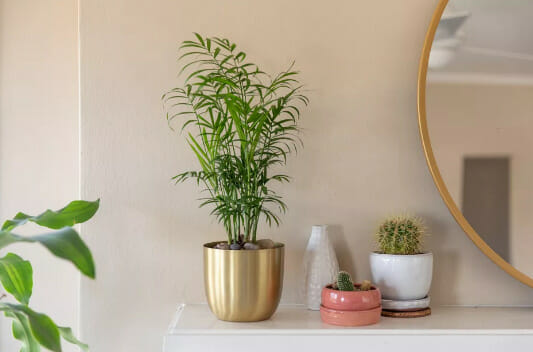
Care Instructions
Parlor palms grow well in medium to bright indirect sunlight. Direct sunlight can burn the leaves. They can tolerate dry conditions but love evenly moist soil. However, ensure that the soil is well-draining and not soggy, as it can cause root rot.
5. Areca Palm
Scientific Name: Dypsis lutescens
Some palms can be toxic for your furry friends, but the areca palm is not one of them. Giving a tropical view to your house, areca plants are unique and low-maintenance plants. Their unique look can make the cats and dogs leap onto them. But worry not; this indoor houseplant is completely safe for your pets.

Care Instructions
Areca Palms thrive in bright, filtered light. Overwatering can cause the roots to rot, so water them often but avoid excessive watering. It is best to water when you feel the soil is completely dry.
6. Polka Dot Plants
Scientific Name: Hypoestes phyllostachya
One of nature’s bewildering crafts is the polka dot plant. The leaves’ red, green, and white alternating dots look no less than an art piece. You can place them in a large white pot to enhance their looks. They are also non-toxic for the pets; however, if ingested in a massive amount, they can cause digestive discomfort among the pets.
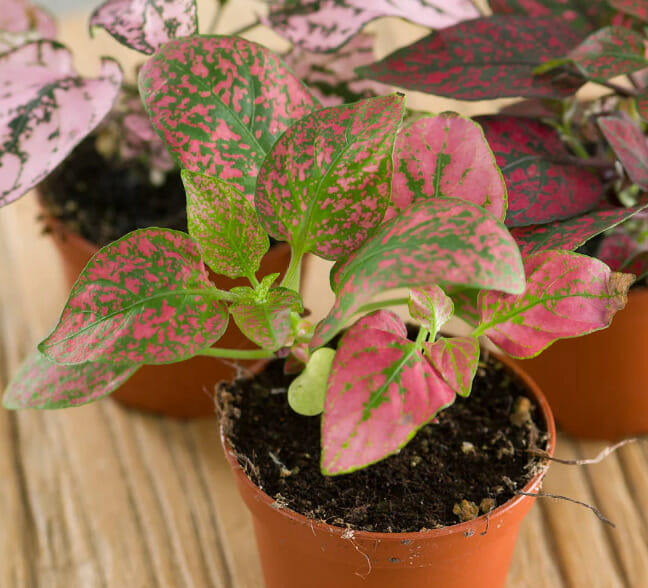
Care Instructions
Polka dot plants have a life span of only 2 years and are not long-lived. However, they are easy to maintain plants. They prefer bright, indirect light with slightly moist soil.
Related Article: How to Grow and Care for Polka Dot Plant?
7. Birds Nest Fern
Scientific Name: Asplenium nidus
Next on the list is the Victoria birds’ nest fern, with pretty wavy and curled leaves. The dark and rich green color is no less than a treat for the eyes. They are super safe and non-toxic indoor houseplants for cats and dogs. So, you don’t need to worry if your fluffies are continuously roaming around your houseplants frequently.

Care Instructions
You just need to be a bit careful while watering since it is recommended to bottom water this plant. Water the fern more when the sun is bright and give less water in low light durations. You can also fertilize them once a month in spring and summer.
8. Boston Fern
Scientific Name: Nephrolepis exaltata
Boston ferns are among the more popular indoor plants. Moreover, they also purify the air by absorbing the toxins. Even if your pets bite their shaggy fronds, there is no need to worry, as Boston ferns are completely safe for cats and dogs.

Care Instructions:
Boston ferns like moist soil and a humid environment. Keep them in indirect, filtered light and avoid overwatering.
9. Prayer Plant
Scientific Name: Maranta leuconeura
As quirky and mesmerizing as it sounds, the prayer plant has curling leaves that look like praying hands at night. Having them at your house will undoubtedly be a great and hassle-free experience since these indoor houseplants are safe and non-toxic for cats and dogs. This is a super durable plant you can keep in your house.

Care Instructions
You can water them two weeks apart occasionally. However, the ideal conditions for praying plants are a green-house environment having enough moisture, fertilizer, and humidity, which is usually not much difficult to maintain for household plants.
10. Peacock Plant
Scientific Name: Calathea makoyana
Calathea is a perfect choice if you have pets at your place, with the striking light and dark pattern of the leaves. There are so many types of Calathea, and all are just amazing in their own ways.
Calathea makoyana is one of their family members with a crazy purple color underneath their leaves which is stunning and mesmerizing. They are super safe for all the pests and thus should be among your top choice when deciding to have non-toxic indoor plants for cats and dogs.

Care Instructions
They require comparatively more moisture and humidity, so consider placing them accordingly. An amazing fact about them is that their leaves start to curl once they are dehydrated and need water. So, you can even judge that without keeping a deep insight into the plants.
11. Bromeliads
Scientific Name: Bromeliaceae
Bromeliads should not be skipped when talking about some unique, eye-catching, and non-toxic indoor houseplants for cats and dogs. The cone within the cluster of green striped long leaves looks really beautiful. Various colored bromeliads in your house can attract your pets, but fortunately, they’re not harmful if ingested. So, you can let your pets play around without worrying about their safety.
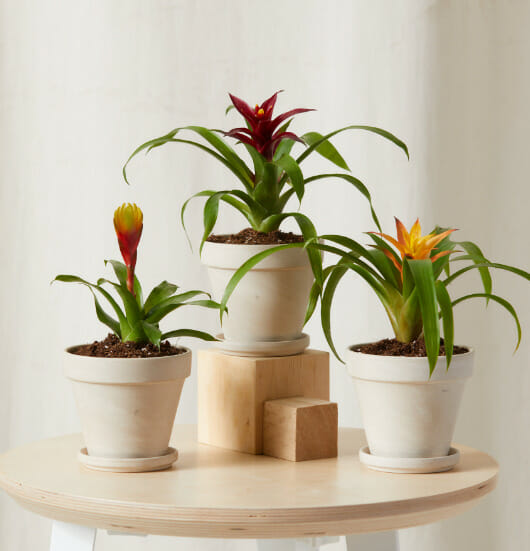
Care Instructions
With its bright and attractive textures and colors, this tropical plant doesn’t make you put any extra effort into its maintenance. You just need to put them in a spot with adequate bright sunlight and mist them occasionally with water spray, and your plants will thrive and grow effectively while keeping your fluffies safe and sound.
12. Orchids
Scientific Name: Orchidaceae
With a fantastic compound of various colors and shapes, the orchids are an excellent choice as a non-toxic pet-friendly indoor plant. If you are fond of various colored beautiful plants thriving and potentially inoffensive for pets, do consider orchids, especially if you are a beginner gardener.
Their beautiful flowers can attract your pets, but you should feel free to place them at any suitable spot without worrying about your fluffies reaching them. Not having any light and soil restrictions, orchids are low maintenance and easy-going.

Care Instructions
They grow well really well during the winter season when most of the other plants halt growing. Most orchids like a humid environment, so if you live in dry areas, you can consider using a humidifier.
13. African Voilet Plants
Scientific Name: Saintpaulia
The beautiful violet hue of the African violet makes them stand out among other house plants. However, the cherry on the top is their pet-friendly nature. It is even edible in some cultures, so the issue of them being toxic to your pets is completely ruled out. You can keep them indoors safely no matter how many times your pets decide to taste or even have a mouthful of bites.
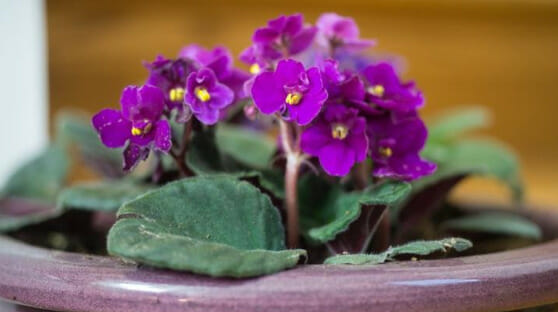
Care Instructions
They thrive well in dry conditions with adequate sunlight, so you don’t need to bother watering them now and then.
14. Cast Iron Plants
Scientific Name: Aspidistra elatior
They are indoor plants that are non-toxic and safe for pets. They have pointed large leaves with a uniform green color that looks aesthetically pleasant and decent. Cast iron plants are extremely low maintenance; therefore, your plants are less likely to suffer even if you are paying more attention to your pet babies.

Care Instructions
They have got super drought tolerance. Moreover, they also adapt well to low or fluctuating light conditions;
15. Rattlesnake Plant
Scientific Name: Calathea lancifola
It is an easy-to-care plant with less watering demand. The beautiful color and distinct leaves make it an amazing addition to your indoor collection. Most importantly, your pets are completely safe near this plant.

Care Instructions
This plant can survive in low-light conditions. And water lightly to keep the soil moist. Avoid soggy soil so the leaves don’t wilt.
16. Haworthia
Scientific Name: Haworthia
Certain succulents are safe for pets, and Haworthia is one of them. This plant looks like aloe vera and has the properties of a typical succulent. It is an easy-to-care, low-maintenance plant and looks fantastic in a ceramic pot decorated with stones and pebbles.
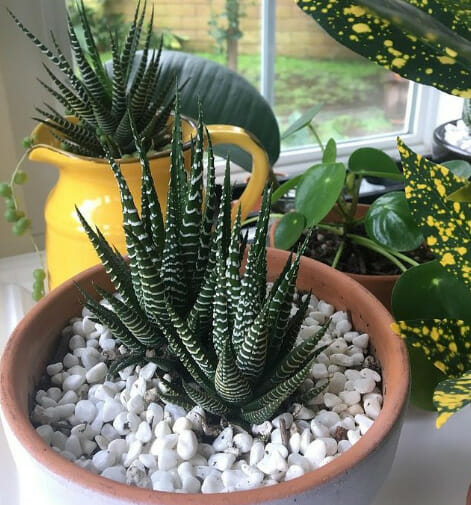
Care Instructions
Like other succulents, Haworthia also likes the bright sun and less water. Water only once a week and check the dryness of the soil for the next watering.
Related Article: 10 Pet-Friendly Succulents That Are Safe for Cats and Dogs
17. Ponytail Palm
Scientific Name: Beaucarnea recurvate
This drought-tolerant plant is ideal for indoors as it doesn’t require much care. Although they don’t grow very tall, the long, lush leaves with thick bulb stem add character to your indoor space. Most importantly, it is one of the indoor houseplants that are safe for cats and dogs.

Care Instructions:
They don’t like much water, so avoid giving them too much water. Moreover, you can fertilize 2-3 times a year for good growth.
18. Echeveria
Scientific Name: Echeveria
Echeveria is the most popular succulent with its beautiful petals and rosette pattern. They are also non-poisonous to your cats and dogs. They make an excellent indoor plant and can be a thoughtful gift item for any plant lover.
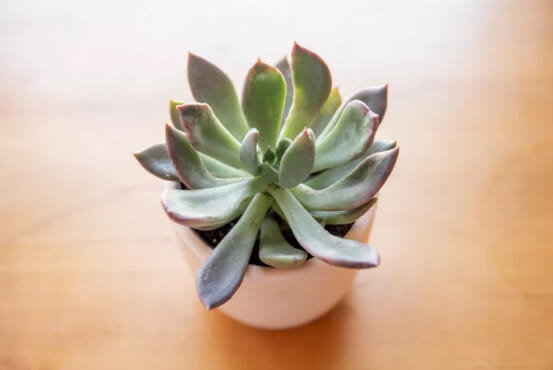
Care Instructions:
It has similar care needs to the other succulents. Put them in bright indirect light and avoid overwatering.
Related Article: 15 Basic Mistakes That Kill Houseplants
Toxic Indoor Houseplants For Cats and Dogs
Not all houseplants are safe for your pets; some can be toxic, causing plant poisoning. Therefore, if you have pets at home, it is important to be fully aware of unsafe plants to keep the poisonous ones out of their reach. Following are some common indoor plants that are toxic for cats and dogs.
- Pothos
- Philodendron
- Aloe Vera
- Sago Palm
- English Ivy
- Hyacinth
- Dieffenbachia
- Lilies
- Caladium (commonly known as Elephants Ears, Pink Cloud, and Mother-in-Law Plant, angel wings, or heart of Jesus)
- Snake Plant (also called Mother-in-Law’s Tongue)
Final thoughts:
Cats and dogs are some of the most adorable and caring pets you can possess. However, keeping them safe and healthy is one of the most significant responsibilities lying on your shoulders. Plants are aesthetically pleasing and good for health, but toxic ones can also pose a significant threat to your pets. Hence you need to take care while choosing to keep plants in your house to enjoy being a pet parent and a gardener at the same time.
If you found this article helpful, visit our website for more articles.
